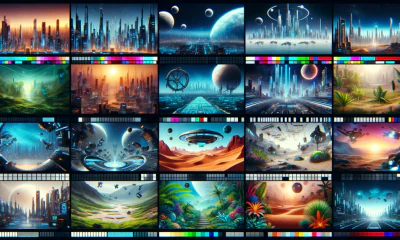Artificial Intelligence
Why Every Company Should Use AI Image Generators

Artificial intelligence (AI) has been making waves across various industries, revolutionizing traditional practices and introducing innovative solutions. One such innovation is AI image generators. These tools have the potential to transform the way businesses operate, offering a new approach to generating visual content.
Understanding AI Image Generators
AI image generators leverage advanced machine learning techniques to create unique and customizable images. They work by taking a user's input, often in the form of text prompts, and generating an image that corresponds to that input. This process involves complex algorithms and machine learning models that have been trained on vast datasets of images.
There are a variety of AI image generators available, view our AI Best Art Generators page.
These tools are designed to be user-friendly, with no need for the user to understand the complex algorithms at work behind the scenes. Users simply enter a search term or a brief description, and the AI generates a unique piece of art or a specific image based on that input.
Benefits of AI Image Generators
AI image generators offer a plethora of benefits that can revolutionize the way companies approach visual content creation. Here are some key advantages:
- Cost and Time Efficiency: Traditional methods of image creation often involve hiring professional graphic designers and waiting for them to produce the desired visuals. This process can be time-consuming and costly. AI image generators, on the other hand, can produce high-quality images in a fraction of the time and at a significantly lower cost. This efficiency can be a game-changer for businesses, especially startups and small businesses with limited resources.
- Infinite Creativity and Customization: AI image generators can create a virtually infinite number of unique images based on user prompts. This allows for a high degree of customization, enabling businesses to create bespoke visuals that align perfectly with their brand identity and marketing objectives. Furthermore, the AI's ability to generate images from text descriptions opens up a world of creative possibilities that would be difficult to achieve with traditional design methods.
- Scalability: As businesses grow, their need for visual content can increase exponentially. AI image generators can easily scale to meet these demands, generating thousands of images in the time it would take a human designer to produce a handful. This scalability can be particularly beneficial for e-commerce businesses that need to generate product images for large inventories.
- Consistency: Maintaining a consistent visual identity across all marketing channels can be a challenge, especially for businesses that produce a high volume of content. AI image generators can help ensure consistency by applying the same design parameters across all images. This can help reinforce brand identity and make marketing materials more recognizable to consumers.
- Accessibility and Ease of Use: One of the greatest benefits of AI image generators is their accessibility. These tools are designed to be user-friendly, requiring no design skills or technical expertise. This means that anyone in a company, from the marketing team to the CEO, can generate images as needed. This democratization of design can foster creativity and innovation throughout the organization.
Use Cases Across Industries
AI image generators have a wide range of applications across various industries. Here are some notable examples:
- Marketing and Advertising: In an industry where visual appeal is paramount, AI image generators can be a game-changer. They can be used to create unique visuals for social media posts, digital ads, and marketing collateral. The ability to generate a high volume of images quickly also makes A/B testing more feasible, allowing marketers to optimize their campaigns based on consumer response.
- E-commerce: For online retailers, product images play a crucial role in influencing consumer purchasing decisions. AI image generators can create high-quality product images, including different angles and variations, without the need for physical photoshoots. This can save time and resources, especially for businesses with large product catalogs.
- Entertainment and Media: In the world of entertainment, AI image generators can be used to create concept art, character designs, and even entire scenes. This can streamline the creative process for filmmakers, game designers, and other creatives, allowing them to visualize their ideas quickly and efficiently.
- Healthcare: In the healthcare industry, AI image generators can be used to create medical illustrations and data visualizations. This can aid in patient education, research, and diagnosis. For example, an AI could generate images illustrating the progression of a disease or the effects of a particular treatment.
- Real Estate: In real estate, AI image generators can be used for virtual staging, property visualization, and even planning and designing new construction projects. This can help potential buyers or investors to visualize properties, enhancing their understanding and interest.
These are just a few examples of the many ways AI image generators can be applied across industries. As the technology continues to evolve, we can expect to see even more innovative uses emerge.
Addressing Potential Concerns
While AI image generators offer numerous benefits, it's also important to address potential concerns and challenges associated with their use. Here are some key considerations:
- Ethical Considerations: The use of AI in any capacity brings with it a host of ethical considerations. In the case of AI image generators, one of the primary concerns is the potential for misuse. For instance, the technology could be used to create deepfakes or other deceptive imagery. It's crucial for companies to implement safeguards and ethical guidelines to prevent such misuse.
- Quality Control: While AI image generators can produce a high volume of images quickly, maintaining a consistent level of quality can be a challenge. AI-generated images may not always meet the standards of professional design, particularly when it comes to complex or nuanced visuals. Companies should have quality control measures in place to ensure that the images produced meet their standards.
- Copyright Issues: AI image generators often rely on large datasets of existing images for training. This raises potential copyright issues, particularly if the AI inadvertently creates images that are similar to copyrighted works. Companies should be aware of these issues and take steps to ensure that their use of AI image generators complies with copyright laws.
- Human Oversight: Despite the capabilities of AI image generators, human oversight remains essential. AI can generate images based on input prompts, but it doesn't understand the context or the subtleties of human communication in the way a human designer would. Therefore, human oversight is necessary to ensure that the images produced are appropriate and effective for their intended use.
How to Implement AI Image Generators in Your Company
Implementing AI image generators in your company can be a game-changer, but it requires careful planning and consideration. Here are some steps to guide you through the process:
- Identify Your Needs: The first step is to identify your company's specific needs. What kind of images do you need to generate? How many images do you need, and how often? Understanding your needs will help you choose the right AI image generator and use it effectively.
- Choose the Right Tool: There are many AI image generators available, each with its own strengths and weaknesses. For instance, Unite.AI's own Images.AI is a powerful and user-friendly option. When choosing a tool, consider factors such as ease of use, customization options, and the quality of the images produced.
- Train Your Team: While AI image generators are designed to be user-friendly, there may still be a learning curve. Provide training for your team to ensure they understand how to use the tool effectively. This could involve tutorials, workshops, or even bringing in an expert for a training session.
- Implement Safeguards: As discussed in the previous section, there are potential concerns associated with the use of AI image generators. Implement safeguards to address these concerns. This could include quality control measures, ethical guidelines, and procedures to ensure compliance with copyright laws.
- Evaluate and Adjust: Once you've implemented an AI image generator, it's important to evaluate its effectiveness and make adjustments as needed. This could involve tracking metrics such as the time saved, the quality of the images produced, and the feedback from your team.
Implementing AI image generators in your company can offer numerous benefits, from increased efficiency to enhanced creativity. However, it's important to approach this process with care, considering both the potential advantages and the challenges.
Harnessing AI Image Generators
AI image generators represent a significant leap forward in the realm of visual content creation. They offer a host of benefits, including cost and time efficiency, infinite creativity, scalability, consistency, and ease of use. These advantages make them a valuable tool for businesses across a wide range of industries, from marketing and advertising to healthcare and real estate.
However, as with any technology, it's important to approach AI image generators with a balanced perspective. While they offer numerous benefits, they also present potential challenges, including ethical considerations, quality control issues, and copyright concerns. It's crucial for businesses to address these challenges proactively, implementing safeguards and maintaining human oversight to ensure responsible use of the technology.
Every company should consider using AI image generators. They offer a powerful way to generate visual content, providing businesses with a competitive edge in today's digital landscape. However, as with any tool, they should be used responsibly, with a clear understanding of both their potential and their limitations. As we continue to explore the possibilities of AI, it's exciting to imagine what the future holds for AI image generators and the businesses that harness their power.














